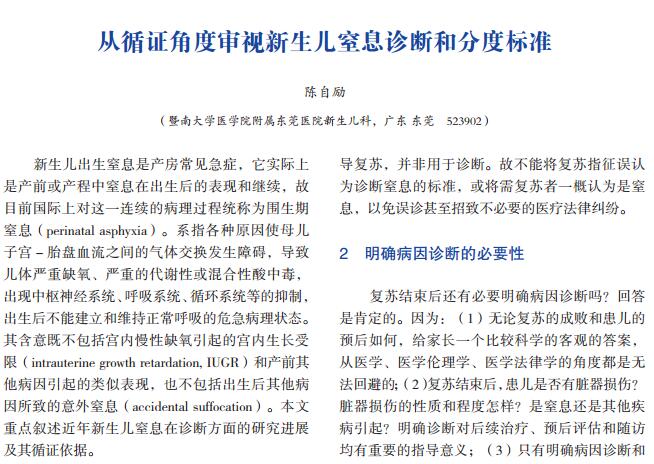 PDF(1042 KB)
PDF(1042 KB)


 PDF(1042 KB)
PDF(1042 KB)
 PDF(1042 KB)
PDF(1042 KB)
从循证角度审视新生儿窒息诊断和分度标准
Assessment of the criteria for the diagnosis and grading of neonatal asphyxia based on evidence
无
No abstract available

[1] American Academy of Pediatrics; American Heart Association. Neonatal Resuscitation[M]. 6th ed. Evanston, Illinois:American Academy of Pediatrics, 2011.
[2] 叶鸿瑁, 虞人杰, 朱小瑜. 中国新生儿复苏指南及临床实施教程[M]. 北京:人民卫生出版社, 2017.
[3] Committee on Fetus and Newborn, American Academy of Pediatrics; Committee on Obstetric Practice, American College of Obstetricians and Gynecologists. Use and abuse of the Apgar score[J]. Pediatrics, 1996, 98(1):141-142.
[4] American Academy of Pediatrics; Committee on Fetus and Newborn, American College of Obstetricians and Gynecologists; Committee on Obstetric Practice. The Apgar score[J]. Pediatrics, 2007, 117(4):1444-1447.
[5] 陈自励. 应防止对Apgar评分的误解[J]. 中国实用儿科杂志, 2001, 16(5):139-140.
[6] 陈自励. 警惕新生儿窒息的误诊误治[J]. 中国实用妇科与产科杂志, 2003, 19(6):321-322.
[7] 陈自励. 新生儿窒息诊断研究最新进展和新诊断标准的建议[J]. 中国小儿急救医学, 2008, 15(1):1-4.
[8] 陈自励. 新生儿缺氧缺血性脑病诊断标准中存在的问题[J]. 中国当代儿科杂志, 2004, 6(1):1-3.
[9] 陈自励. 应防止对Apgar评分的误解和误用[M]//陈自励. 新生儿窒息和多脏器损伤诊疗进展. 北京:人民卫生出版社, 2014:49-58.
[10] Thorp JA, Rushing RS. Umbilical cord blood gas analysis[J]. Obstet Gynecol Clin North Am, 1999, 26(4):695-709.
[11] 陈自励, 何锐智, 彭倩, 等. 新生儿窒息诊断标准改进的临床研究[J]. 中华儿科杂志, 2006, 44(3):167-172.
[12] 新生儿脐动脉血气指标研究协作组. 新生儿脐动脉血气诊断新生儿窒息的多中心临床研究[J]. 中华儿科杂志, 2010, 48(9):668-673.
[13] MacDonald MG, Seshia MMK, Mullett MD. Avery's Neonatology[M]. 6th ed. Philadelphia:Lippincott Williams & Wilkins, 2006:304-326.
[14] Klieman RM, Behrman RE, Jenson HB, et al. Nelson Textbook of Pediatrics[M]. 18th ed. Philadelphia:Elsevier Inc, 2008:(Chapter 99) 5.
[15] Leuthner SR, Das UG. Low Apgar score and the definition of birth asphyxia[J]. Pediatr Clin North Am, 2004, 51(3):737-745.
[16] González de Dios J. Definition of perinatal asphyxia in medical literature:the need for consensus[J]. Rev Neurol, 2002, 35(7):628-634.
[17] Adock LM, Speer ME. An evaluation on specificity of the ACOG criteria for perinatal asphyxia[J]. Pediatrics, 1998, 102(3):770.
[18] Phelan JP, Ahn MO, Korst L, et al. Intrapartum fetal asphyxia brain injury with absent multiorgan dysfunction[J]. J Matern Fetal Med, 1998, 7(1):19-22.
[19] Korst LM, Phelan JP, Wang YM, et al. Acute fetal asphyxia and permanent brain injury:a retrospective analysis of current indicators[J]. J Matern Fetal Med, 1999, 8(1):101-106.
[20] Murphy-Kaulbeck L, Bland E, Oppenheimer L, et al. Neonatal Encephalopathy and Asphyxia:Revisiting Diagnostic Criteria[M]. Otawa:Canadian OB/GYN Society, 2000.
[21] 中国医师协会新生儿专业委员会. 新生儿窒息诊断和分度标准建议[J]. 中国当代儿科杂志, 2013, 15(1):1.
[22] 陈自励, 何锐智, 彭倩, 等. 新生儿窒息的危险因素:危险几何[J]. 中国当代儿科杂志, 2009, 11(3):161-165.
[23] 陈自励, 刘敬. "新生儿窒息诊断和分度标准建议"解读[J]. 中国当代儿科杂志, 2013, 15(1):2-4.
[24] 陈自励. 新生儿窒息产前危险因素研究进展[M]//陈自励. 新生儿窒息和多脏器损伤诊疗进展. 北京:人民卫生出版社, 2014:42-48.
[25] 陈自励. 新生儿窒息诊断的理论基础和循证医学依据[M]//陈自励. 新生儿窒息和多脏器损伤诊疗进展. 北京:人民卫生出版社, 2014:23-41.
[26] Kumari S, Sharma M, Yadav M, et al. Trends in neonatal outcome with low Apgar scores[J]. Indian J Pediatr, 1993, 60(3):415-422.
[27] Thorngren-Jerneck K, Herbst A. Low 5-minute Apgar score:a population-based register study of 1 million term births[J]. Obstet Gynecol, 2001, 98(1):65-70.
[28] Berglund S, Norman M, Grunewald C, et al. Neonatal resuscitation after severe asphyxia-a critical evaluation of 177 Swedish cases[J]. Acta Peadiatr, 2008, 97(6):714-719.
[29] Stuart A, Otterblad Olausson P, Källen K. Apgar scores at 5 minute after birth in relation to school performance at 16 years of age[J]. Obstet Gynecol, 2011, 118(Pt 1):201-208.
[30] Pálsdóttir K, Thórkelsson T, Hardardóttir H, et al. Birth asphyxia, neonatal risk factors for hypoxic ischemic encephalopathy[J]. Laeknabladid, 2007, 93(10):669-673.
[31] Wong L, MacLennan AH. Gathering the evidence:cord gases and placental histology for births with low Apgar scores[J]. Aust N Z J Obstet Gynecol, 2011, 51(1):17-21.
[32] Olusanya BO, Solanke OA. Correlates of birth asphyxia using two Apgar score classification methods[J]. Nig Q J Hosp Med, 2010, 20(4):153-161.
[33] Misra PK, Srivastava N, Malik GK, et al. Outcome in relation to Apgar score in term neonates[J]. Indian J Pediatr, 1994, 31(10):1215-1218.
[34] ACOG Committee on Obstetric Practice. ACOG Committee Opinion No.348.:umbilical cord blood gas and acid-base analysis[J]. Obstet Gynecol, 2006, 108(5):1319-1322.
[35] Blickstein I, Green T. Umbilical cord blood gases[J]. Clin Perinatol, 2007, 34(3):451-459.
[36] 陈自励. 脐血血气分析的临床意义[J]. 中国实用妇科与产科杂志, 2004, 20(1):21-23.
[37] 陈自励. 脐动脉血气在新生儿窒息诊断中的意义和价值[J]. 中华围产医学杂志, 2006, 9(1):24-27.
[38] 陈自励. 脐动脉血气分析在围生期医学领域的正确应用[J]. 中国当代儿科杂志, 2010, 12(1):1-4.
[39] 孙运梅. 新生儿窒息新诊断标准在临床实践中的认识和体会[J]. 中国医药科学, 2016, 6(24):62-65.